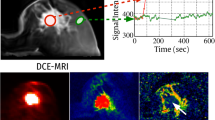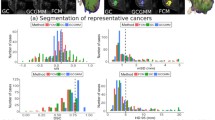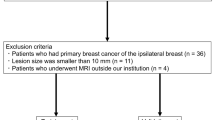Abstract
Purpose
The present study aimed to determine suitable optimal classifiers and investigate the general applicability of computer-aided diagnosis (CAD) to compare magnetic resonance (MR)-CAD with MR imaging (MRI) in distinguishing benign from malignant solid breast masses.
Methods
We analyzed a total of 251 patients (mean age: 44.8 ± 12.3 years; range: 21–81 years) with 274 breast masses (154 benign masses, 120 malignant masses) using a Gaussian mixture model and a random forest machine model for segmentation and classification.
Results
The diagnostic performance of MRI alone and MRI plus CAD were compared with respect to sensitivity, specificity, and area under the curve (AUC), using receiver operating characteristic curve analysis. The discriminating power to detect malignancy using MR-CAD with an AUC of 0.955 (sensitivity was 95.8% and the specificity was 92.9%) was significantly higher than that of MRI alone with an AUC of 0.785 (sensitivity was 71.7% and the specificity was 85.7%).
Conclusion
CAD is feasible to differentiate breast lesions, and it can complement MRI, thereby making it easier to diagnose breast lesions and obviating the need for unnecessary biopsies.




Similar content being viewed by others
References
Mariscotti G, Houssami N, Durando M et al (2014) Accuracy of mammography, digital breast tomosynthesis, ultrasound and MR imaging in preoperative assessment of breast cancer. Anticancer Res 34:1219–1225
Lee-Felker SA, Tekchandani L, Thomas M et al (2017) Newly diagnosed breast cancer: comparison of contrast-enhanced spectral mammography and breast MR imaging in the evaluation of extent of disease. Radiology 285:389–400
Warner E, Plewes DB, Hill KA et al (2004) Surveillance of BRCA1 and BRCA2 mutation carriers with magnetic resonance imaging, ultrasound, mammography, and clinical breast examination. JAMA 292:1317–1325
Radhakrishna S, Agrwal S, Parikh PM et al (2018) Role of magnetic resonance imaging in breast cancer management. South Asian J Cancer 7:69–71
Roganovec D, Djilas D, Bujnovic S et al (2015) Breast MRI, digital mammography and breast tomosynthesis: comparison of three methods for early detection of breast cancer. Born J Basic Med Sci 15:64–68
Kanao S, Karaoka M, lima M et al (2018) Differentiating benign and malignant inflammatory breast lesions: value of T2 weighted and diffusion weighted MR images. Magn Reson Imaging 50:38–44
Jalalian A, Mashohor S, Mahmud R et al (2017) Foundation and methodologies in computer-aided diagnosis systems for breast cancer detection. EXCLI J 20:113–137
Honda E, Nakayama R, Toyama H et al (2016) Computer-aided diagnosis scheme for distinguishing between benign and malignant masses in breast DCE-MRI. J Digit Imaging 29:388–393
Song SE, Seo BK, Cho KR et al (2015) Computer-aided detection (CAD) system for breast MRI in assessment of local tumor extent, nodal status, and multifocality of invasive breast cancers: preliminary study. Cancer Imaging 8:1
Chaddad A, Luedi M, Zinn PO et al (2017) Corrigendum to “automated feature extraction in brain tumor by magnetic resonance imaging using gaussian mixture models”. Int J Biomed Imaging 2017:1
Banaie M, Soltanian-Zadeh H, Saligheh-Rad HR et al (2018) Spatiotemporal features of DCE-MRI for breast cancer diagnosis. Comput Methods Progr Biomed 155:153–164
Gallego-Ortiz C, Martel AL (2016) Improving the accuracy of computer-aided diagnosis for breast MR imaging by differentiating between mass and non mass lesions. Radiology 278:679–688
Gubern-Merida A, Marti R, Melendez J et al (2015) Automated localization of breast cancer in dynamic contrast-enhanced-MRI. Med Image Anal 20:265–274
Spainhour JC, Janech MG, Schwacke JH et al (2014) The application of Gaussian mixture models for signal quantification in MALDI-TOF mass spectrometry of peptides. PLoS ONE 9:e111016
Gan H, Sang N, Huang R (2015) Manifold regularized semi-supervised gaussian mixture model. J Opt Soc Am A 32:566–575
Kawabata T (2018) Gaussian-input Gaussian mixture model for representing density maps and atomic models. J Struct Biol 203:1–16
Naidu BR, Babu MSP (2018) Biometric authentication data with three traits using compression technique, HOG, GMM and fusion technique. Data Brief 18:1976–1986
Fan Ming, Zhang Peng, Wang Yue et al (2019) Radiomic analysis of imaging heterogeneity in tumours and the surrounding parenchyma based on unsupervised decomposition of DCE-MRI for predicting molecular subtypes of breast cancer. Eur Radiol. https://doi.org/10.1007/s00330-018-5891-3
LindsayWD Ahern CA, Tobias JS et al (2018) Automated data extraction and ensemble methods for predictive modeling of breast cancer outcomes after radiation therapy. Med Phys 25:15. https://doi.org/10.1002/mp.13314
Huang YH, Chang YC, Huang CS et al (2013) Computer-aided diagnosis of mass-like lesion in breast MRI: differential analysis of the 3-D morphology between benign and malignant tumors. Comput Methods Progr Biomed 112:508–517
Acknowledgements
The study was supported by Postdoctoral Science Foundation of Ministry of Heilongjiang Province (Grant number LBH-Z17150).
Author information
Authors and Affiliations
Corresponding author
Ethics declarations
Conflict of interest
None of the authors of this manuscript have a financial interest related to this work. Author’s institutions have no conflicts of interest.
Additional information
Publisher's Note
Springer Nature remains neutral with regard to jurisdictional claims in published maps and institutional affiliations.
Rights and permissions
About this article
Cite this article
Yu, Q., Huang, K., Zhu, Y. et al. Preliminary results of computer-aided diagnosis for magnetic resonance imaging of solid breast lesions. Breast Cancer Res Treat 177, 419–426 (2019). https://doi.org/10.1007/s10549-019-05297-7
Received:
Accepted:
Published:
Issue Date:
DOI: https://doi.org/10.1007/s10549-019-05297-7




